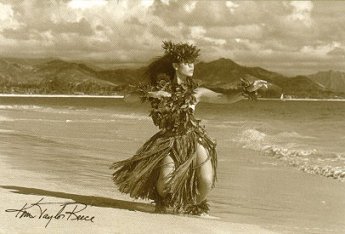

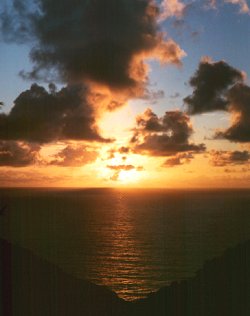 |
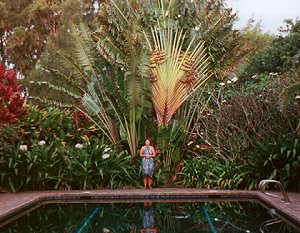 |
| From the place we stayed, we had a view of the sunrise everyday, if we were up that early, which we usually were, due to the frogs below the window. We were at that place, on Maui, for a week in April 1997. | The place we stayed had a pool next to the building in which we stayed. Here is Michele in the distance, standing in front of the banana trees. The trees were different because, unlike the usual banana trees I've seen, these were palmate: the fronds were all in one plane. The fruit was smaller than commercial bananas, and more orange. On the left are ginger and on the right, pulmeria. While we were there we bought a pulmeria stick and planted it when we returned, so now we have a small pulmeria bush. |
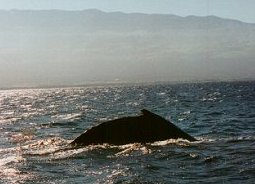 |
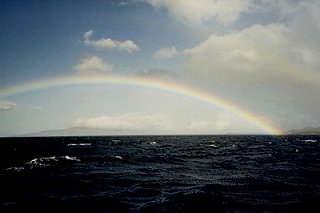 |
| We also went whale watching one day. The boat followed, from a distance, a female with calf and escort. The boats are not permitted to pursue the whales within some distance, though the whales can come to the boats. Humpbacks go to Hawai'i during the winter to give birth, because of the warm water conditions. The females will often have a male escort. I didn't get a picture of a fluke (the tail), but plenty of arched backs. The whales only showed their flukes twice. During the trip, the whales went under the boat once. We could see their dark forms as they went under, only to breach just off the side of the boat. I didn't have the camera ready. Imagine that. | Little of the time on the whale-watching trip was actually spent watching whales, it's mostly watching FOR whales and seeing the rainbows caused by the sea spray. |
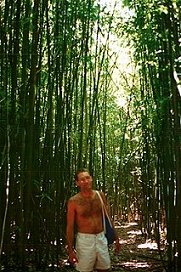 |
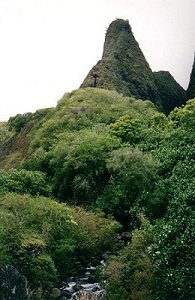 |
| Near our place was a bamboo forest on the way to a stream. The water was too cold to swim in, but the stream was rocky and had some nice falls. By rocky, I mean ROCKS, boulders, that is. The forest was hot and muggy, but the leaves cast a green light on everything and the bamboo made a nice sound when the canes hit together in the breeze. | On the Western part of the island, we visited the Iao Valley and walked around, it's a stay-on-the-path-type park, and is an ancient cinder cone. The picture shows the cone. It's a very wet area, and a stream runs through it. |
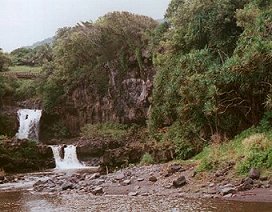 |
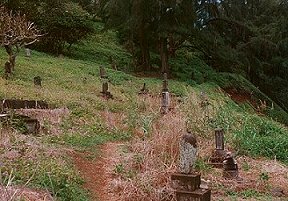 |
| The place we stayed was on the road to Hana, and of course, we drove down there. In retrospect we could have done without that, because we had the interesting features of the trip near us, so we just wasted a lot of time driving. The road to Hana is also very curvy, so it can be rough on passengers. Along the way are trails through forests and along streams and waterfalls. The Seven Pools, the lower ones are shown here, is the main one of these. We didn't go up to the upper pools, but they are beyond the bridge in the background on the left. | Farther down, in south Hana, there is an old Japanese cemetery that is slowly eroding into the sea. The stones here have kanji characters on them, so I don't know how old they are. Down in the ocean there are fallen grave stones along the shoreline as well. |
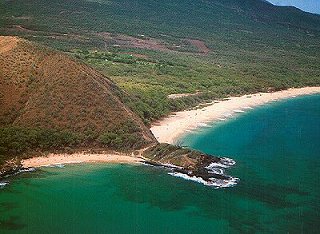 |
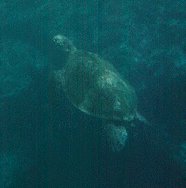 |
| Yes, we also went to the beach. Shown here is an aerial, oblique photo of Makena Beach. Little Beach on the left and Big Beach on the right. We didn't spend any time over on the Big Beach, prefering the little side, where we baked in the sand, played in the waves, and also went snorkeling. | While snorkeling we brought along a single-use, underwater-capable camera, which we used to take fish pictures. They didn't come out too well, because we didn't dive to get side shots of them: fish are narrow from above. There was a turtle swimming around. Similar to the laws for whales, snorkelers are not allowed to chase the turtles, which was fine with us because we didn't dive. This is the best photo of the green sea turtle. |
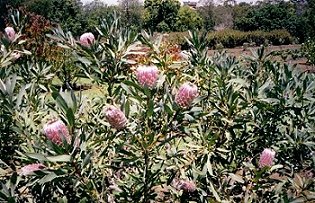 |
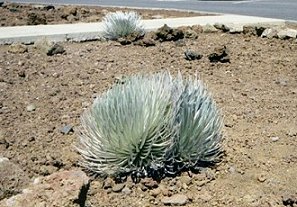 |
| Of course, we drove up to Haleakala, but, as I mention later, we didn't go up for the sunrise. On the way up, we stopped at the protea farm and Michele had a good look around. | At the top there wasn't much to see, because it's just a dead caldera. The mountain is the last place to find Silverswords. These are ones in the parking lot. Hopefully people will be careful with them. They only live on the slopes of Haleakala and are only pollenated by a particular bee, which is also endangered. |
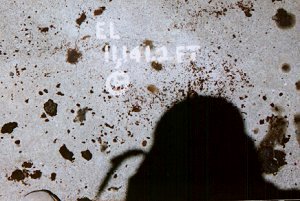 |
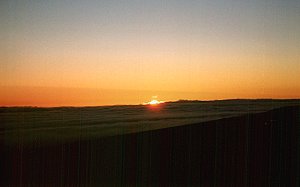 |
| At the end of April, I went to the Big Island to calibrate a sun photometer at the Mauna Loa weather observatory. This is the elevation marker at the observatory: 11,141.2 ft (3395.8 m). It was cold, dry, and windy up there. The dark spots are oil stains or pepples. That, of course, is my shadow. While on the Big Island, we (those of us calibrating) stayed in Hilo. | For the instruments we had to be up on the mountain, ready, at sunrise. This is sunrise over the clouds on one such morning. One thing people do on Maui is wake up early and drive up to the top of Haleakala to see this, or they combine this with mountain biking down, by paying a tour company to drive them and a trailer full of bikes to the top. |
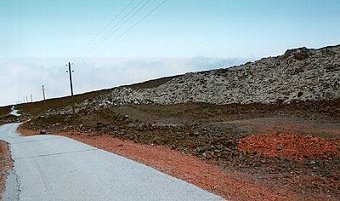 |
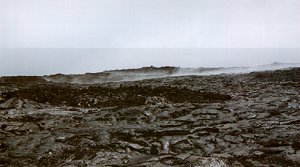 |
| This is the Mauna Loa road, heading down. The road is obviously that silver ribbon stretching off on the left. It's 16 miles from saddle road to the observatory, the second half of which is paralleled by the power line. The drive in the morning was uneventful: it was just a matter of following the road in the dark and (on the lower part) fog. On the way down we could see what we were driving past: a mountain of lava and more lava. There are too types on the mountain: smooth and rough. The smooth type flowed with higher temperatures and is dark gray. The rough type is like gravel and often redish. The road bed was constructed with red, rough lava. | Rolling hills of smooth lava along the Mauna Loa road. That is fog out there, not smoke or steam. |
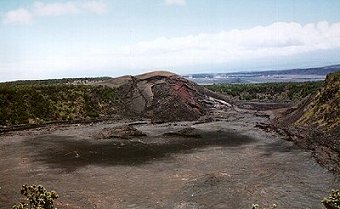 |
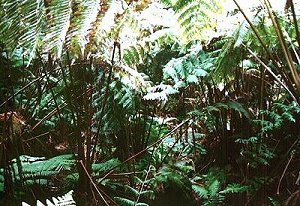 |
| The last day on the island I had some free time, so I went driving around to see some of the sights. This is Kilauea Iki crater. Off in the distance to the right is Kilauea itself. Near Kilauea there are steam vents, that smell like sulfur. The steam itself was blown horizontal when it left the ground because the wind was so strong. I thought the car door was going to get ripped off, when I opened it up there. All the craters at the Volcano National Park are only "pimples on the back of Mauna Loa". That slope in the background on the right is the south slope of Mauna Loa. The observatory is on the north slope, but much higher up. | In amongst the craters is a lava tube (Thurston), with a fern tree forest along the path, which was strange to see this microclimate surrounded by all the barren lava. |
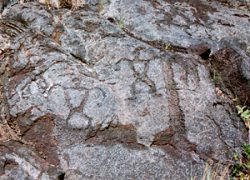 |
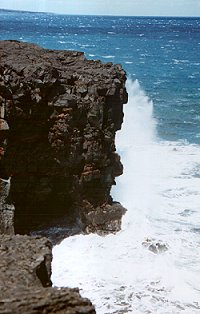 |
| Along the south shore of Hawai'i are some petroglyph sites, areas where the native Hawaiians carved human figures in the lava rocks. Here are a few of the male figures. |
Waves crash against the lava cliffs on the south shore, sending up sea spray
unto the rocks, and people (me) above. There is an arch down there, but it is
cast in shadow.
On the way down from Volcano National Park, I stopped at Akatsuka Orchid Gardens and bought one for my mom. |
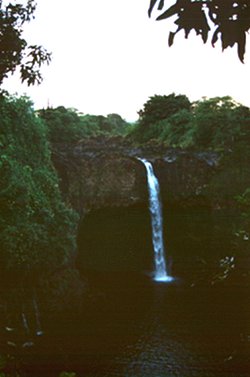 |
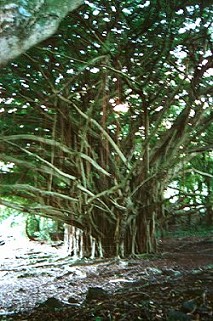 |
| Before heading out to the volcanoes, I visited Rainbow Falls outside of Hilo, and took this shot in the early morning light. | Behind the falls there is a big banyan tree. I stayed at the Hilo Hawaiian, which is on Banyan drive, called that because it is lined by banyan trees. The trees are all branch, there's no trunk in there. |
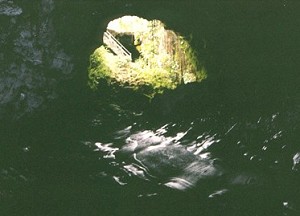 |
|
| On the way down from the mountain one day, I stopped at the lava tube park and went inside a little way. Next time, I'll bring a flashlight. This is the view looking out, of course. | |
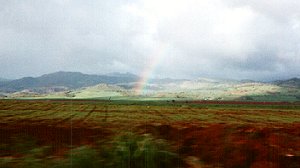 |
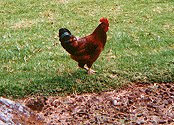 |
| In October 1997, I went to Kaua'i, again for work. It rained almost every day, and one day, as I was driving home, I took this shot out of the driver's side window. That is a sugar cane field in the middle ground. We stayed in the Poipu area, which is on the south side of the island. There are a lot of cane fields here and they burn some every day, making Hawaiian snow: ashes. The ashes blow around with the sand on the beach. | Chickens were everywhere on the island. This rooster was one of many at the Kokee State Park camp ground. |

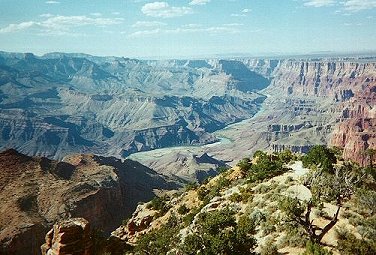
The top image is a photomosaic of three pictures of Waimea Canyon, the grand canyon of the Pacific. There are light and dark patches here due to the cloud patterns, which didn't quite make it into the picture. The hills are red, like most of the soil on Kauai'i (the iron in the lava), but unlike the real Grand Canyon, the hills here also have green on them, because the canyon gets much rain. I didn't take many pictures on Kaua'i, but I did manage to get to the beach some when I wasn't working, no beach pictures: hey, it's only sand and waves.
Compare that to the real Grand Canyon in the American southwest. This picture was taken my my mom in 1995. It's certainly bigger, but dryer.
Back to Brad's page
Last updated: 2 Feb 2000